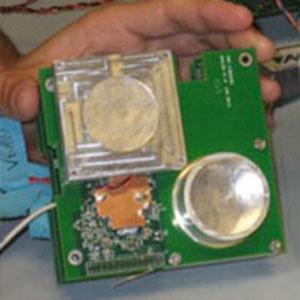Two identical 1.5U (10 x 10 x 15cm) CubeSat spacecraft, each weighing up to 2 kg., will be placed into a common high-inclination bead-on-a-string orbit. Each satellite will carry a two solid-state detector charged particle sensors with different geometric factors optimized to cover electron measurements over the energy range from 0.25 to ~1 MeV in six differential energy channels.
Detectors are read out by a custom application-specific integrated circuit (ASIC), designed by The Aerospace Corporation, called the Dual Amplifier Pulse Peak Energy Rundown ASIC. Onboard memory stores fast sample observations needed to resolve spatial structure; survey observations identify times of interest to download the highest temporal resolution data within the limited telemetry stream. While all data from the instruments are saved on board for ~4 weeks, FIREBIRD telemeters a reduced event identification data product to the ground each day in order to select particular intervals with microbursts to download for scientific analysis. The satellites will remain within ~400 km of one another for up to four months, allowing characterization over the spatial scale regime from 10-300 km.

FIREBIRD Schematic
A computer aided design drawing of a FIREBIRD satellite. CubeSat standards specify a 10 x 10 x 10cm cube as 1U. Each FIREBIRD is a 1.5U structure; the upper 1/2U is the sensor assembly (FIRE) developed by Univ. of N.H.; the bottom 1U is the spacecraft bus (BIRD) developed by Montana State Univ.

Sensor Assembly
An Engineering model of a single FIREBIRD satellite. The sensor assembly detector apertures are seen on top.

Sensor
A single engineering unit sensor assembly. The sensor assembly houses two solid-state detectors, one (bottom right corner) collimated and the other (top left corner) uncollimated.
Implementation Responsibilities
| MSU |
Satellite bus and subsystems Integration and testing Tracking, command and telemetry from MSU ground station Science analysis and publication of results |
| LANL/UNH |
Payload design and development Science operations center Science analysis and publication of results |
| Aerospace Corp |
Sensor development assistance Sensor calibration assistance Industry internship(s) for students |